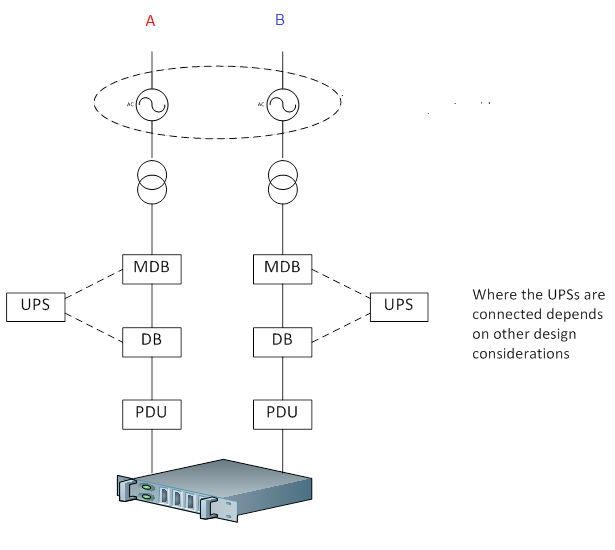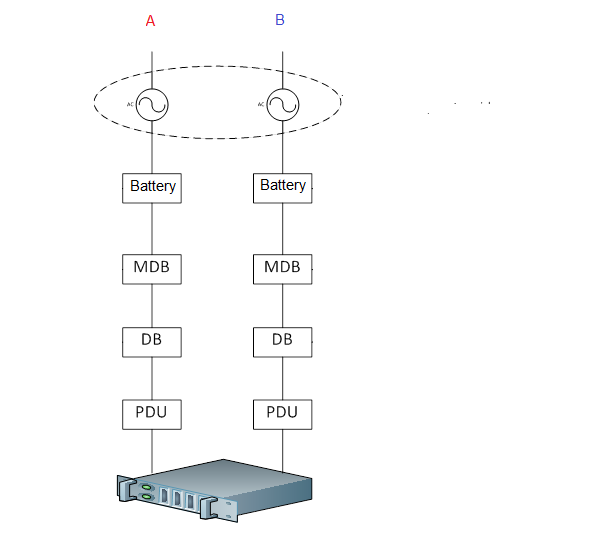Here’s the back of a typical server (taken from the HP DL380 spec sheet):
Those things with the fans in the bottom right are the Power Supply Units (PSUs) – i.e. where you plug the power in. Servers have two of them and, in a conventional data center, each PSU is connected to a separate source. The exact configuration depends on what tier the data centre is; here’s a typical arrangement for Tier 3/4:
So, if we start at the bottom, each PSU is connected to a local distribution panel (PDU). Each of these will in turn usually go back to an intermediate distribution panel (DB) which in turn goes to the main distribution panel (MDB). Each MDB will go to its own power source or sources – usually a combination of gen sets and utility / grid power. The way in which the UPSs are fitted between the DBs and MDBs depends on various factors which needn’t detain us here.
This is daft.
- The computer itself does not need 230V AC / 110V AC. It needs DC.
- The battery pack for a typical UPS supplies DC.
- So, in a conventional design, when the computers run off UPS power, we take DC from the batteries, turn it into AC, send it to the computer, and turn it back to DC.
- Those two conversions cancel each other out.
Talk to any telecoms person, and they’ll confirm the daftness. Telecoms has used 48V DC pretty much since Alexander Graham Bell invented the modern telephone, and conventional land lines to this day leave the exchange at 48V DC. So why would one use AC to begin with?
One possible answer is power loss. When you transmit electricity down wires, some electricity is lost in the form of heat. The amount of power lost is proportional to the square of the current. As the total power is the product of the voltage and current, high voltage and low current results in less power loss than low voltage and high current. The downside to this is that higher voltages are more lethal than lower voltages, but we can set that to one side for this post.
Is power loss something that should concern us in a data centre? The maths is straightforward so let’s take some typical numbers.
- An average server consumes 500W of power.
- There is 100 meters of wire between the server and its power source.
- The power loss in the wire has a resistance of 6E-8 Ohms per meter (I got the numbers from here, and took a mid-point).
So, in a conventional set-up, the power is delivered as 250V AC, and the current will be 2 Amps (250V * 2A = 500W), and the power loss will be
(2A)^2 * 100M * 6E-8Ω/M = 0.000024W
If the power is delivered as 5V DC, the current will be 100 Amps, and the power loss will be
(100A)^2 * 100M * 6E-8Ω/M = 0.06W.
That is proportionally a huge difference. But the AC calculation does not include the loss in converting from AC to DC and back again. Even if that’s only 0.1% both ways, that’s an additional .5W to convert DC to AC at the inverters and the same again to convert AC back to DC in the PSUs, for a total of 1.000024W, which is rather a lot more than 0.06W. So DC-DC is the clear winner.
This raises two questions. The first is whether it’s worth worrying about; the second is what to do about it if we should worry about it.
If your data centre has 500 racks and 10 servers per rack, that’s 5,000 servers. The total power loss for AC is 5,000*1.000024= 5000.12W. If we deliver DC, the total power loss is 5,000*0.06 = 300W. However, in both cases, the total power required by the IT is 500*5,000 = 2,500,000W. Whether the power loss is 5000.12W or 300W, it’s negligible compared to the total load. So, on a pure numbers basis, it’s immaterial.
But, and as I said in my first post in this series, I’m taking a holistic view of “green.” I’m not just worried about how economical a data centre can be in its usage of power. I’m also concerned about minimizing the overall carbon footprint. If we’re to do that, we need to look further than calculations such as the above. In terms of the power loss, the difference between AC and DC is negligible. But getting rid of 10,000 PSUs and some pretty beefy inverters does make a difference. Manufacturing that stuff – and destroying it safely when it’s finished – has an impact. That impact is not only avoidable; all those inverters and PSUs cancel each other out: they are functionally equivalent to nothing. So, if we’re to take “green” at all seriously, ditch the lot.
The next objection will be that batteries supply 12V and most computers need 3.3V, 5V or 12V. As it happens, the industry is moving towards a single 12V supply, with conversion to the lower voltages being done on the motherboard. But batteries can be designed for pretty much any voltage and, just as data centers today offer the choice between 2- and 3-phase, there’s no reason they can’t offer the choice between different DC voltages.
Another advantage of DC is less wire. Most computer equipment today has three wires: live, neutral and earth. With 110V/230V, the earth is necessary as these voltages are lethal. 12V is not lethal, and it is safe to ground the neutral wire in a DC circuit (it isn’t with AC). The average data center contains literally tons of copper wiring and reducing three wires to two is a hell of a lot less copper to quarry, refine, turn into wire and ship, and a hell of a lot less PVC to insulate it with.
And, yes, supplying DC direct to the computers would save a lot of money: no invertors, far fewer PSUs, and a third less wire.
So: what to do about it? The obvious and simplest answer is that we make the primary source of power for the computer equipment the battery pack:
Now, this may seem like a simple change, and I have been quite deliberate in making the minimum possible change to the drawings to maintain this illusion. However,putting on my Accredited Tier Designer hat, there remains a serious issue if one’s operating within the Uptime Institute framework. According to UI, the primary source of power for a data centre is the on-site power generation. That on-site power must be able to run the data center indefinitely, and should have a minimum capacity of 96 hours. If the primary power source is the batteries, the battery pack for 96 hours would be gargantuan.
I’ll fix that in the next post.






Leave a Reply
You must belogged in to post a comment.